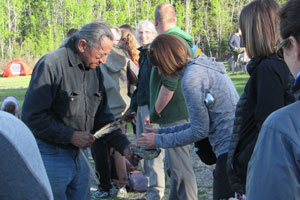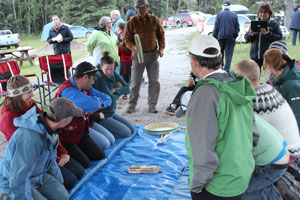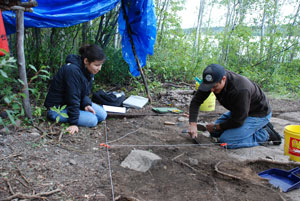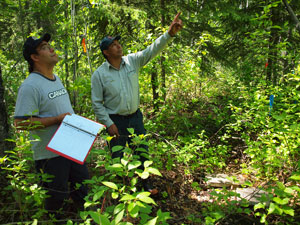
HSMBC Plaque Ceremony for Francois Beaulieu II (Died 1872) - Photo of the descendants of this founding father of the NWT Metis
Archeological evidence shows that Indigenous people have inhabited the region that is now Wood Buffalo National Park for more than 8000 years, long before fur traders arrived in the early 1700s. The communities around the park today are mostly made up of Cree, Chipewyan, Metis and non-indigenous people.

ceremony for the WBNP Bioblitz participants
When Wood Buffalo was created in 1922 (north of the Peace River) the land was considered to be ‘taken up’ and all Aboriginal rights were considered extinguished. However, given the large area to be taken up as a National Park, eliminating all harvesting was not considered reasonable. As a result, Wood Buffalo National Park became the first national park in Canada to allow Indigenous traditional harvesting. However, while innovative at the time, this approach was not implemented in a way that treated harvesting by all Indigenous people in a fair fashion. Only First Nation members who were harvesting on the lands established as a park were allowed to continue harvesting. Families with strong ties to park lands who were not actively harvesting in the park when the park was established were not considered eligible. Métis members who had been harvesting on lands that became the new park were not permitted to continue to harvest in the park. After park establishment traditional harvesting was considered a “privilege”, not an Aboriginal or Treaty Right, and permits were limited in number.
In 1926 the park was expanded south of the Peace River into the Peace Athabasca Delta to protect the bison transported from the south, which had migrated across the Peace River. A more inclusive approach to harvesting was adopted. Everyone harvesting in the park at the time of expansion, both Indigenous and non-Indigenous, were eligible for a permit. Permits were however still based on being in the park at the time of expansion. Again families with strong ties to the new park lands who were not actively harvesting in the park when the park expanded were not considered eligible.

Annual Dark Sky Festival held in
Wood Buffalo National Park
In both the original establishment and the expansion of the park the decisions to exclude certain Indigenous members of a community, for the reasons stated earlier, resulted in divisions between members where they did not exist before.
This complicated history has been a negative one for all involved but was especially unfair to Indigenous people. Over the years this “privilege” was passed down to the children of the original harvesters and a registry was established at the park to track hereditary eligibility, numbers of harvesters and number of permits issued. Specific harvesting regulations were developed that set up a management framework for Indigenous harvesting but were not based on Rights and set seasons and limits on the number of harvesters eligible.
Over the years the privileged based system continued to be an issue of concern for local Indigenous people. Real change did not happen until two key Supreme Court of Canada cases were concluded:

Traditional Use cabin.
- 1) In 2003 the R. v. Powley decision recognized the Métis right to hunt in the Sault Ste Marie area. The case also provided a test to determine if Powley-type Rights existed elsewhere. Research done in this area found that the local Indigenous Métis would likely have Powley-type hunting rights. The Government of Canada’s response for the park area was to respect the Métis assertion of Rights. Since 2003 local Indigenous Metis have exercised their Asserted Right to hunt in the park and have been involved in various park management objectives, including cooperative management.
- 2) In 2005 the Mikisew Cree First Nation v. Canada decision was released. As part of that decision the court recognized that there was an existing right under Treaty 8 to hunt, fish and trap for personal use within the park. This effectively struck down the privilege based system that had been in use since 1922.
Subsistence hunting, fishing and trapping occurs today in Wood Buffalo National Park, as it has for centuries. The result of these Supreme Court of Canada decisions is that Parks Canada now recognizes the Treaty 8 Right to harvest in the park and the Asserted Rights of the Métis. Traditional, subsistence harvesting continues to be an important part of the ecological and cultural identity of Wood Buffalo National Park.

Indigenous Cultural site.
A thorough understanding of traditional and scientific information is critical to protecting the ecological and cultural integrity of Wood Buffalo National Park. Traditional cultural use by Indigenous harvesters preserves and transmits Indigenous culture to future generations and contributes to the sharing and growth of Indigenous ecological knowledge of the land and waters in and around the park.
The Park continues to explore opportunities to work cooperatively with its Indigenous partners . This is captured and supported in the 2010 Wood Buffalo National Park Management Plan under Key Strategy 1, Towards a Shared Vision which is located at: http://www.pc.gc.ca/en/pn-np/nt/woodbuffalo/info/plan/plan1
The history of the establishment and operation of the park has been negative for the Indigenous communities and confusion remains regarding Harvesting Rights. Through the Aboriginal Committee for the Cooperative Management of Wood Buffalo National Park, which meets a number of times per year, and bilateral projects and relationships, Parks Canada and local Indigenous partners are working toward a better future, one that better respects and represents the importance of the local Indigenous communities to the park.
Our 11 Indigenous partners include:
| Province of Alberta | Northwest Territories | |||
|---|---|---|---|---|
| Fort Chipewyan: | Fort Smith: | |||
| 1) Mikisew Cree First Nation 2) Athabasca Chipewyan First Nation 3) Fort Chipewyan Metis |
1) Salt River First Nation 2) Fort Smith Metis Council |
|||
| Garden River: | Hay River: | |||
| 1) Little Red River Cree First Nation | 1) K'atl'Odeeche First Nation 2) Hay River Metis Council |
|||
| Fort Fitzgerald: | Fort Resolution: | |||
| 1) Smith Landing First Nation | 1) Deninu Kue First Nation 2) Fort Resolution Metis Council |
- Date modified :